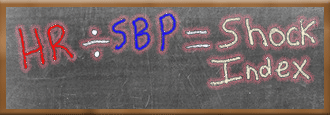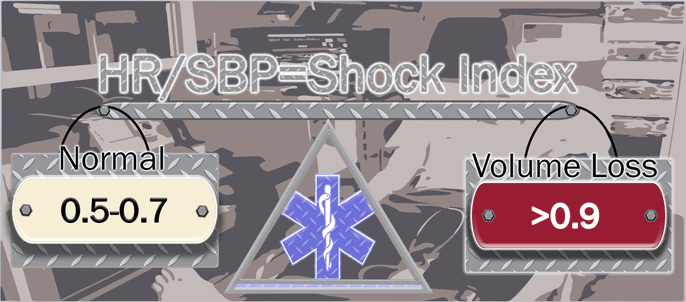TOOLS OF THE TRADE: SHOCK INDEX
You have that “gut feeling” that your patient is bleeding somewhere (or has a significant intravascular volume loss) but you have no obvious blood (or fluid) loss to prove it... and the vital signs aren’t that bad….
Consider calculating the patient’s shock index as a part of your initial and ongoing assessments!
Here are some frequently asked questions (FAQs):
Q: What is shock index?
A:Shock index is a very easy, yet valid and reliable calculation - based on your patient’s heart rate and the systolic blood pressure - that helps you to identify potential shock patients.
Q: How important or significant is shock index anyway?
A: Studies have found shock index to be a very reliable indicator for volume loss. In fact, shock index has been shown to be more sensitive than vital signs alone in suggesting the presence of occult (hidden) shock. So, it may help identify occult bleeding even when the vital signs are close to a normal range.
Q: How is shock index calculated?

A: Heart rate divided by the systolic blood pressure. That’s it!
Q: What is a normal shock index?
A: Normal shock index is between 0.5 and 0.7.
Q: Example?
A: HR Is 100 and the SBP is 90. Therefore: 100÷90=1.1
Q: What does 1.1 mean?
A: A shock index higher than 0.9 means your “gut feeling” is on the right track. This is an important finding to report, and the trauma surgeons and Emergency Medicine physicians will appreciate the head’s up that will allow them to prepare to search for the source!
Q: Doesn’t pain make your HR go up, which would cause SI to be falsely elevated?
A: Yes it does, but pain tends to also raise SBP, so Shock index should not change. Also, pain medication will tend to depress both HR and SBP, so giving a dose of fentanyl, for example, should not appreciably alter Shock index.
Q: Can shock index be useful for non-trauma patients?
A: Yes. Shock index has been shown to be an effective assessment tool for severe sepsis. (Berger,et al.,2013). It has also been studied as an important indicator of shock in cardiology patients. (Huang, et al., 2014)
Q: What if I just can’t take the time to do the math?
A: If the HR is greater than the SBP, then your patient’s shock index is greater than 1. A shock index of 1 is significant!
Q: What are the next steps? Should I start using it?
A: There is nothing invasive about reporting a shock index – it is simply another great tool in your assessment toolbox.
You could report it by saying “the HR is 110 and the SBP is 90, so the patient has a shock index that is greater than 1…”

If you would like to know more, here’s a list of references that describe Shock Index in more detail!
Or feel free to contact:Dr. Timothy Pohlman, Trauma Services, IU Health Methodist Hospital.
References
Berger , T., Green , J., Horeczko, T., Hagar , Y., Garg, N., Suarez , A., . . . Shapiro, N. (2013). Shock Index and early recognition of sepsis in the emergency department. Retrieved from Medscape: http://www.medscape.com
Bruijns, S. R., Guly , H. R., Bouamra, O., Lecky, F., & Lee, W. A. (2013). the value of traditional vital signs, shock index and age-based markers in predicting trauma mortality . Journal of Trauma Acute Care Surgery, 74, , 1432-1437.
Guly , H., Bouamra, O., Spiers, M., Dark, P., Coats, T., & Lecky, F. (2011). Vital signs and estimated bloood loss in patients with major trauma: Testing the validity of the ATLS classification of hypovolemic shock. Resuscitation, 82,, 556-559.
Hasler , R. M., Nuesch, E., Juni , P., & Bouamra, O. (2011). Systolic blood pressure below 110 mmhg associated with increased mortality in blunt major trauma patients: multicentre cohort study. Resuscitation, 1202 - 1207.
Huang, B., Yang, Y., Zhu, J., Liang, Y., Tan, H., Yu, L., . . . Li , J. (2014). Usefullness of the admission shock index for predicting short term outcomes in patients with ST-segment elevation myocardial infarction. American Journal of Cardiology, 114, 1315-1321.
Kulvatunyou, N., Pandit, V., Hashmi, A., Tang, A., Khalil, M., O'Keefe, T., . . . Rhee, P. (2014). Shock index predicts mortality in geriatric trauma patients: An analysis of the national trauma data bank. Journal of Trauma Acute Care Surgery,76,, 1111-1115.
Mitra, B., Fitzgerald, M., & Chan, J. (2014). The utility of a shock index greater than or equal to 1 as an indication for pre-hospital oxygen carrier administration in major trauma . Injury, 45, 61-65.
Mutschler, M., Nienaber, U., Munzberg, M., Fabian, T., Paffrath, T., Wolfl, C., . . . Maegele, M. (2014). Is the PHTLS classification of hypovolemic shock really valid? . Emergency medicine journal, 31 (1), , 35-40.
Pandit, V., Rhee, P., Narong, K., Hashmi , A., Kulvatunyou, N., Tang, A., . . . Joseph , B. (2014 ). Shock index predicts moratlity in geriatric trauma patients: an analysis of the national trauma data bank. Journal of Trauma Acute Care Surgery , 1111-1115.
Vandromme, M., Griffin , R., Kerby , J., McGwin , G., Rue, L., & Weinberg , J. (2011, Feb). Identifying risk for massive transfusion in the relatively normotensive patient:utility of the prehospital shock index. Retrieved from Pubmed Web site: http://www.ncbi.nlm.nih.gov/pubmed
Wira , C. R., Francis, M. W., Bhat, S., Ehrman , R., Conner, D., & Siegel, M. (2014). The shock index as a predictor of Vasopressor use in emergency department patients with severe sepsis . Western Journal of Emergency Medicine, 15, 60-66.
If you would like to read more articles Please Click Here to access the archived articles from our web site.